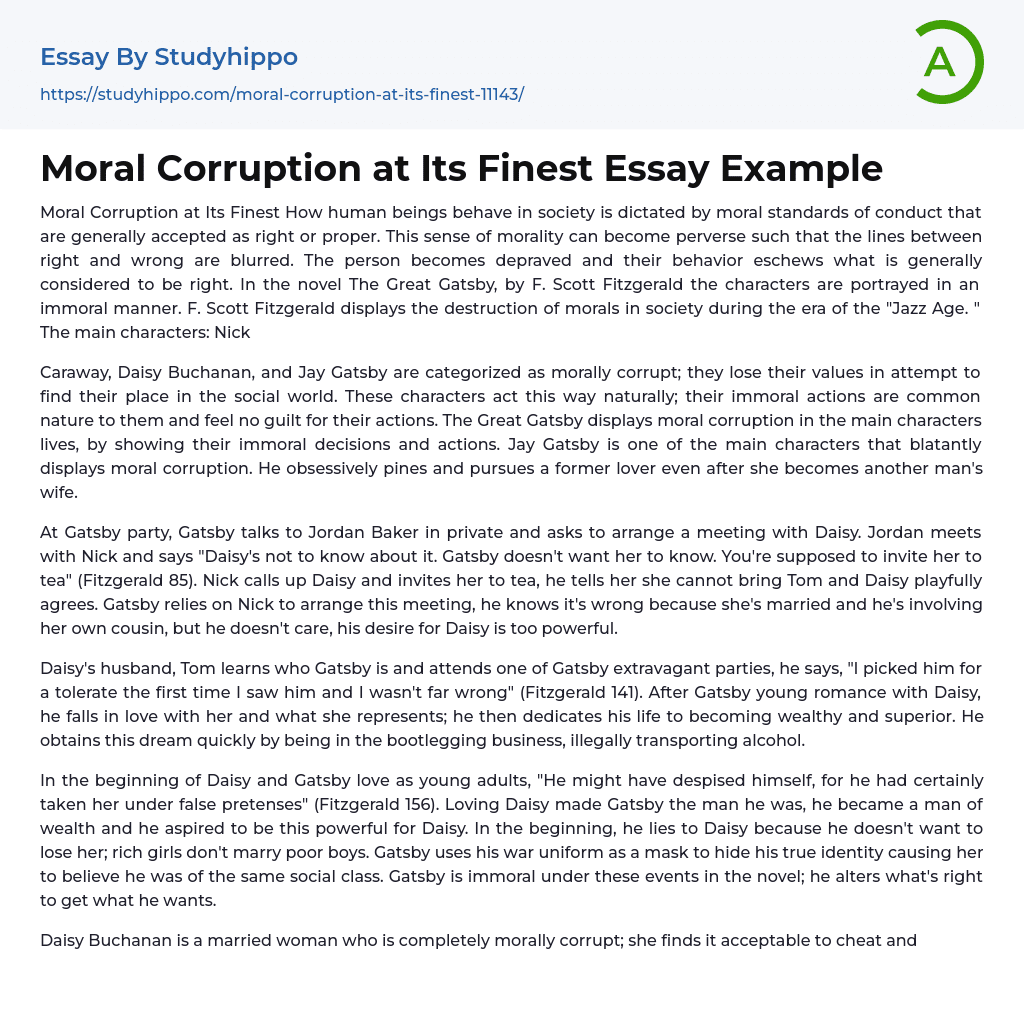The novel The Great Gatsby, authored by F. Scott Fitzgerald, portrays moral corruption in society during the "Jazz Age" era. The main characters, namely Nick Caraway, Daisy Buchanan, and Jay Gatsby, are depicted as morally corrupt individuals who sacrifice their values in their pursuit of social status. Their immoral actions come effortlessly to them without any sense of guilt. One instance of moral corruption is evident through Jay Gatsby's infatuation with a former lover who is presently married to another man. Gatsby goes to great lengths to orchestrate a clandestine meeting with her while ensuring that Daisy remains unaware of their plans (Fitzgerald 85). Nick invites Daisy for tea but forbids her from bringing Tom along. Despite knowing it is wrong since Daisy is not only married but also his own cousin, Gatsby relies on Nick to ar
...range the rendezvous. However, his intense desire for Daisy outweighs any concerns he may have had in this matter. When Tom discovers Gatsby's identity and attends one of his extravagant parties, he initially shows tolerance towards him by admitting that his judgment was not entirely off base. After experiencing a brief romance with Daisy, Gatsby falls deeply in love with her and the notion she represents. He dedicates his life to acquiring wealth and superiority—a feat he accomplishes through illegal activities within the bootlegging industry. In the early stages of their relationship, Gatsby acknowledges deceiving Daisy by luring her under false pretenses.
His love for Daisy transforms him into a man of wealth and power, driven by the fear of losing her. Gatsby utilizes his war uniform to conceal his true identity and deceive Daisy, making her believe
that they belong to the same social class. Throughout the novel, Gatsby manipulates situations to fulfill his desires, disregarding moral standards. Daisy Buchanan is portrayed as morally corrupt; she believes it is acceptable to cheat and lie for her own happiness. She married Tom Buchanan solely for his money, not out of love (Fitzgerald 80). Furthermore, she seeks social status and power through Tom's wealth. Daisy's actions reveal her indifference towards others' feelings and her relentless determination to obtain what she wants (Fitzgerald 39). For instance, she kisses Gatsby in their home while her husband is nearby and guests are present (Fitzgerald 122). This casual display of affection demonstrates her selfish pursuit of happiness. Despite causing harm, such as when she kills Myrtle with her car, Daisy never takes responsibility for her actions but instead leaves others to clean up the messes she creates (Fitzgerald 187). She proves herself to be self-centered and insensitive towards others' feelings as long as it satisfies her own desires. On the other hand, Nick Caraway attempts to maintain peace with everyone but compromises his own ethical values in doing so. Despite being Daisy's cousin, Nick does not object much when he meets Tom's mistress or when cheating and lying occur freely around himGatsby enlists Nick's aid in reconnecting with Daisy, even though he knows she is married. Despite this knowledge, Nick arranges a secret meeting between them and chooses not to disclose Daisy's involvement in Myrtle's death to protect Gatsby's reputation. This decision reveals Nick's own moral corruption, as his actions contradict his claims of decency. The Great Gatsby by F. Scott Fitzgerald features several morally corrupt characters fixated
on their self-centered lifestyles in the East. Serving as a mediator for all the immoral failures in the novel, Nick Caraway portrays himself as nonjudgmental but ultimately embodies depravity by blurring the lines between right and wrong consistently. Gatsby himself becomes consumed by an obsessive belief driven by love that leads to reckless destruction and a loss of moral compass. Meanwhile, Daisy combines fancifulness, impulsiveness, and cunningness to maintain her societal standing while pursuing impulsive desires and earthly pleasures that exemplify how seeking social acceptance can result in moral decay. Ultimately, the moral ambiguity displayed by Nick, Daisy, and Gatsby culminates in one individual being destroyed while others continue living immoral lives without facing consequences.
- Absolutism essays
- Appeal essays
- Bourgeoisie essays
- Contras essays
- Corporate Governance essays
- Corruption essays
- Democracy essays
- Democratic Party essays
- Developed Country essays
- Dictatorship essays
- Elections essays
- European Union essays
- Federalism essays
- Foreign essays
- Foreign policy essays
- Gentrification essays
- Hillary Clinton essays
- Income Tax essays
- International Relations essays
- John Marshall essays
- John Stuart Mill essays
- Left-Wing Politics essays
- Liberty essays
- Military essays
- Monarch essays
- Monarchy essays
- Political Corruption essays
- Political Party essays
- Political Science essays
- President Of The United States essays
- Public Service essays
- Red Cross essays
- Reform essays
- Republic essays
- Revenge essays
- Social Security essays
- Sovereign State essays
- State essays
- Supply essays
- Terrorism essays
- United Nations essays
- World Trade Organization essays
- Aldous Huxley essays
- Alice Walker essays
- Amy tan essays
- Anne Bradstreet essays
- Anton Chekhov essays
- Arthur Miller essays
- Augustine essays
- Bertolt Brecht essays




